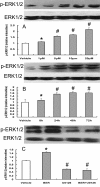Decrease in the production of β-amyloid by berberine inhibition of the expression of β-secretase in HEK293 cells
- PMID: 22152059
- PMCID: PMC3253691
- DOI: 10.1186/1471-2202-12-125
Decrease in the production of β-amyloid by berberine inhibition of the expression of β-secretase in HEK293 cells
Abstract
Background: Berberine (BER), the major alkaloidal component of Rhizoma coptidis, has multiple pharmacological effects including inhibition of acetylcholinesterase, reduction of cholesterol and glucose levels, anti-inflammatory, neuroprotective and neurotrophic effects. It has also been demonstrated that BER can reduce the production of beta-amyloid40/42, which plays a critical and primary role in the pathogenesis of Alzheimer's disease. However, the mechanism by which it accomplishes this remains unclear.
Results: Here, we report that BER could not only significantly decrease the production of beta-amyloid40/42 and the expression of beta-secretase (BACE), but was also able to activate the extracellular signal-regulated kinase1/2 (ERK1/2) pathway in a dose- and time-dependent manner in HEK293 cells stably transfected with APP695 containing the Swedish mutation. We also find that U0126, an antagonist of the ERK1/2 pathway, could abolish (1) the activation activity of BER on the ERK1/2 pathway and (2) the inhibition activity of BER on the production of beta-amyloid40/42 and the expression of BACE.
Conclusion: Our data indicate that BER decreases the production of beta-amyloid40/42 by inhibiting the expression of BACE via activation of the ERK1/2 pathway.
Figures




References
-
- Sastre M, Dewachter I, Rossner S, Bogdanovic N, Rosen E, Borghgraef P, Evert BO, Dumitrescu-Ozimek L, Thal DR, Landreth G, Walter J, Klockgether T, van Leuven F, Heneka MT. Nonsteroidal anti-inflammatory drugs repress beta-secretase gene promoter activity by the activation of PPARgamma. Proc Natl Acad Sci USA. 2006;103(2):443–8. doi: 10.1073/pnas.0503839103. - DOI - PMC - PubMed
Publication types
MeSH terms
Substances
LinkOut - more resources
Full Text Sources
Medical
Miscellaneous

